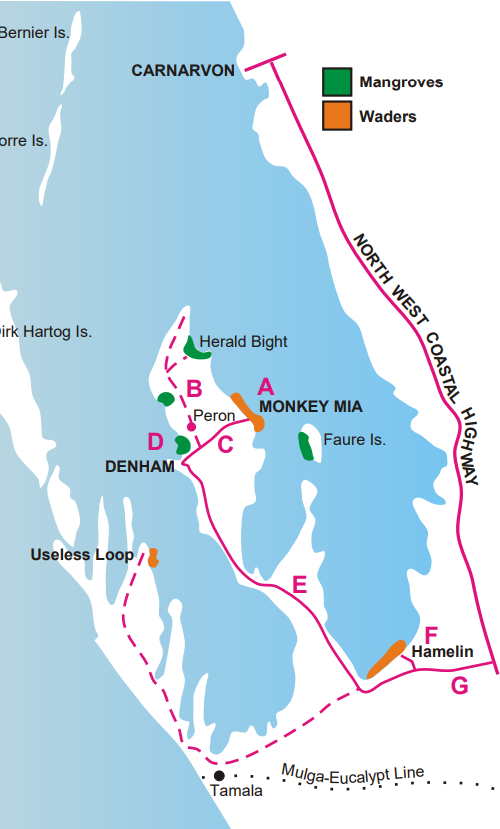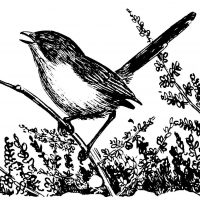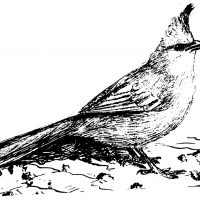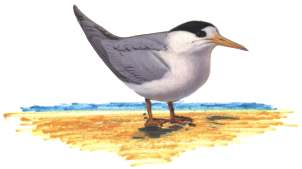Shark Bay Bird Watching guide
BIRDWATCHING AROUND SHARK BAY
The Shire of Shark Bay is the western most point of Australia. The history, geology and natural features of this region are so significant that Shark Bay has been recognised as a World Heritage Area.
The area is the boundary of two major botanical regions – the acacia/mulga dominated area to the north and the eucalypt dominated area to the south of Tamala. The wide range of habitats – bays, mangroves, islands, salt lakes, salt marsh, coastal, mulga and scrub support over 165 species of birds.
Denham is the only town in the area and has accommodation, World Heritage Discovery and Visitor Centre, Parks and Wildlife as well as Shire offices. Call at these offices for information on the places of interest to visit.
A Monkey Mia
Monkey Mia is world famous for its Bottle-nose Dolphins. There is also much to offer the birder at Monkey Mia. Start by looking in the car park for Thick-billed Grasswren and White-browed Babbler. Please note that there is a park visitor fee.
The Shark Bay World Heritage Discovery and Visitor centre in Denham has a lot of information available. Ask for a bird list and details of the walk trails. Around and in front of the visitor centre look for Australian Pelican, Pied Cormorant, White-plumed Honeyeater, Variegated Fairy-wren and White-winged Fairy-wren.
The Explorer’s Walk Trail is an excellent walk especially early in the morning. It leads from the car park, up to a small dam, through some coastal scrub and down to the beach from where you can walk back to the information centre. Allow 2 to 3 hours for the walk so that you can take your time and be patient to see some of the shyer species.
At the start of the walk look for Thick-billed Grasswren, White-winged Fairy-wren and Variegated Fairy-wren. Look for Common Bronzewing, Crested Pigeon, Zebra Finch and Emu coming to drink at the dam. There is a bird hide where you can sit and wait patiently.
Further along in the low scrub look for Thick-billed Grasswren, Chiming Wedgebill, Southern Scrub-robin and Crested Bellbird. You need to be patient to get good observations, although the Southern Scrub-robin can be very inquisitive if you stay still and whistle quietly. Keep an ear out for Horsfield’s Bronze-Cuckoo and Black-eared Cuckoo.
When you get to the beach you will see a sand spit further down the beach to the right. This is a very good site especially in summer to look for waders and terns. There should be Bar-tailed Godwit, Common Greenshank, Pied Oystercatcher, Grey Plover, Lesser Sand Plover, Greater Sand Plover, Red-capped Plover, Red-necked Stint, Curlew Sandpiper, Ruddy Turnstone and a possible Terek Sandpiper. There could also be Silver Gull, Caspian Tern, Crested Tern, Fairy Tern and possibly Pacific Gull and Lesser Crested Tern. You might also see Little Egret or Eastern Reef Egret.
B Francois Peron National Park
The Francois Peron National Park is a large area that is mostly accessible only by high clearance 4WD, although you can drive to the Peron homestead in a 2WD. Access to the park is 4 km from Denham on the Monkey Mia Road. There are some excellent areas such as Big Lagoon and Herald Bight. Malleefowl have been reintroduced to the peninsula.
C Golf Course
This is along the road from Monkey Mia to Denham. Look for Emu, Banded Lapwing, Chiming Wedgebill, Whitebrowed Scrubwren, Little Crow and honeyeaters.


Thick-billed Grasswren
The western sub-species is classified as vulnerable and now only found on the fringe of its former range.

The Chiming Wedgebill
can often be heard calling from a low branch ‘but did you get drunk’ in monotonous repetition.
WHAT IS BIRDLIFE AUSTRALIA?
BirdLife Australia is a non-profit national organisation working for the enjoyment, study and conservation of Australia’s birds. Birdlife Western Australia has members statewide and offers a variety of activities for members, including conservation and research projects.
Activities and services include excursions, camp-outs, bird surveys and social activities. We also have a library, books for sale and information about birds.
To view our full range of bird guides and bird lists, visit our web site.
INTERESTED?
Contact us at:
Peregrine House
BirdLife WA Office
167 Perry Lakes Drive
Floreat WA 6014
Office Hours: Mon – Fri, 9.30am – 12.30pm
Phone: (08) 9383 7749
Email: wa@birdlife.org.au

Prepared by BirdLife Western Australia
BIRDWATCHING
AROUND
SHARK BAY
Number 6AB in a series of
Bird Guides of Western Australia

Fairy Tern

D Little Lagoon
This is an excellent half-day walk from Denham or you can drive to the lagoon and look for an hour or two around the lagoon and the mangrove-lined creek. Walk north along the beach to the mouth of the creek. Look for waders and terns. Then follow the creek looking for Common Sandpiper, Mangrove Grey Fantail, Yellow White-eye, Sacred Kingfisher and possibly Striated Heron. Look around the shores of the lagoon for a few waders.
The shrubs provide a habitat for many small birds such as Richard’s Pipit, White-browed Scrubwren, Splendid Fairywren, Variegated Fairy-wren and White-winged Fairy-wren. Walk back to Denham along the main road.
E Denham to Hamelin Pool Caravan Park
Along the road there are a number of salt lakes that can be worth stopping at to look for waders, and in the salt marsh you might see Rufous Fieldwren or Orange Chat. Look for White-backed Swallow, Nankeen Kestrel and Fork-tailed Swift flying overhead in summer. Look for Zebra Finch and Richard’s Pipit in the low areas of vegetation.
F Hamelin Pool Caravan Park
This is an excellent place to stay and birdwatch. Look for birds along the road such as Hooded Robin, Chestnut-rumped Thornbill, Southern Whiteface and Varied Sittella. Check the salt marsh for White-winged Fairy-wren, Brown Songlark, and perhaps Orange Chat and Slender-billed Thornbill. Check the caravan park for Spiny-cheeked Honeyeater, Whiteplumed Honeyeater, Pied Honeyeater, Crested Pigeon,Rainbow Bee-eater, Pied Butcherbird, Little Crow, Silvereye and possibly Black-eared Cuckoo. Visit the beach to look at the stromatolites, the oldest living fossils in the world. While in the area you may see waders and Pied Cormorants. To contact the Hamelin Pool Caravan Park call 08 9942 5905
G Hamelin Bay to Overlander Roadhouse
There are two windmills that are visible south of the road. These are good areas to look for Banded Lapwing, Chiming Wedgebill, White-browed Babbler, Crested Bellbird, Australian Ringneck, Hooded Robin, Red-capped Robin, White-winged Triller, Varied Sittella, White-winged Fairywren, Crimson Chat, Zebra Finch and Horsfield’s BronzeCuckoo.
Seas, Shores and Islands
Shark Bay provides spectacular coastal scenery and rich waters for many sea and shore birds. Summer visitors include Wedge-tailed Shearwater and possibly Streaked Shearwater. Winter visitors include Australasian Gannet, Wilson’s StormPetrel and possibly Yellow-nosed Albatross. Osprey, Whitebellied Sea-Eagle, gulls, terns and Wedge-tailed Shearwaters are among the birds that breed on the islands throughout the area.
See the map for the areas marked as mangroves, and the areas where the migratory waders congregate.
There are boat tours that leave daily from Monkey Mia to cruise part of Shark Bay. Look for the Bottle-nose Dolphins, Dugong, terns, gulls and seabirds.
Dirk Hartog Island is a National Park and, Dorre and Bernier Islands are protected nature reserves for several species of critically endangered mammals. They have large colonies of Wedge-tailed Shearwaters and breeding areas for several species of terns.
Dirk Hartog Island is home for the ‘black and white’ form of the White-winged Fairy-wren. The male has distinctive black and white wings and a blue tail. Dirk Hartog Island also has the sub species hartogi of the Southern Emu-wren which is now probably declining in numbers. Dirk Hartog Island also has a surprising variety of raptors including White-bellied Sea-Eagle, Spotted Harrier, Brown Goshawk, Brown Falcon, Nankeen Kestrel and occasionally Little Eagle and Wedgetailed Eagle.
For more information, contact the Shark Bay World Heritage and Discovery Centre (1300 367 072).
